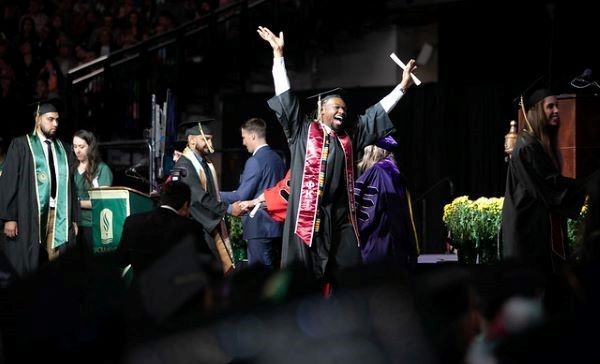 A growing number of Sacramento State students are able to revel in their accomplishments, as this young man does during 2019 Commencement, with figures showing a dramatic increase in the University's four-year graduation rate. (Sacramento State/Andrea Price)
A growing number of Sacramento State students are able to revel in their accomplishments, as this young man does during 2019 Commencement, with figures showing a dramatic increase in the University's four-year graduation rate. (Sacramento State/Andrea Price)By Cynthia Hubert
Sacramento State is on pace to shatter CSU goals for improving graduation rates, more than doubling its percentage of students who are “finishing in four” over the past three years, the University’s latest data show.
Sac State projects that 20.4 percent of 2019 graduates completed their course work in four years, up from 8.8 percent in 2016.
The University’s graduation czar, Jim Dragna, said the jump is one of the highest in the country during that time – but he is not satisfied.
“All indications suggest that we’ll have even further gains in the future,” Dragna said. “We’d like to see every student who wishes to graduate do so in a timely manner.”
Dragna’s office, University Initiatives and Student Success, has been driving Sac State’s “Finish in Four” and “Through in Two” programs. They are part of California State University’s Graduation Initiative 2025, a push to boost graduation rates among incoming freshmen and transfer students.
As part of the graduation campaigns, participating incoming freshman and transfer students pledge to take 15 units each semester, or 30 units per year including summer classes, and in turn are provided academic and administrative support.
All Sac State students are benefitting from expanded resources such as additional faculty members, hundreds of new course selections, thousands of classroom seats, summer scholarships and counseling, and electronic platforms to plan classes and track progress, Dragna said.
Since “Finish in Four” launched in the summer of 2016, Sac State’s graduation rates have steadily increased. Last year, the four-year graduation rate was 14.7 percent for first-time freshmen, the highest rate in three decades.
Projections for 2019 suggest that rates improved among all categories of students, including Pell Grant recipients and those who were the first in their families to attend college.
Transfer students also saw significant gains. This year, about 45 percent of transfer students are projected to have earned their undergraduate degrees in two years, compared to 27 percent in 2016.
CSU, in its system-wide initiative, has set 2025 graduation goals for each of its 23 campuses. Sac State's goal for four-year graduations is 33 percent, but Dragna said he expects the University to significantly exceed that benchmark, perhaps surpassing 40 percent by 2025.
“We have sustainable growth,” he said. “We are consistently progressing upward, and I don’t see that changing.”
Dragna attributes the impressive gains in graduation rates to a “culture change” that has transformed how students, parents and faculty think about the importance of completing undergraduate degrees more quickly.
“The idea is that getting to college is not the only goal," he said. "Graduating and beginning a career is a goal.” By graduating in four years, students can save money, enter the work force sooner in their chosen fields, and inspire other family members to do the same, Dragna said.
His office surveyed 1,202 undergraduate students at Commencement ceremonies in May, finding that 32 percent already were employed in a field related to their career goals. About 18 percent were either enrolled in a postgraduate education program or were planning to enroll.
“We are making progress because we are working in partnership with our students,” Dragna said. “All we have done is offer them a challenge, and given them the tools to make their journey a little easier. It’s still hard work. It still requires a lot of pride and dedication.”
Many other campuses in the CSU system, which takes pride in offering higher education to students who may face financial, cultural, language and other barriers, also have seen significant graduation gains in recent years. The CSU system's cumulative four-year graduation rate in 2018 was 25.5 percent; CSU's four-year goal for 2025 is 40 percent.
Sac State has one of the most diverse campuses in the system, and many students arrive at the University with significant obstacles that could hinder their success, Dragna noted.
“Yet right across the board, students are increasing their graduation rates,” he said. “Our students have accepted the challenge and are making it happen.”
Dragna said the University is fielding inquiries from colleges across the country seeking a blueprint for improving their graduation rates.
Jeff Gold, CSU assistant chancellor for Student Success, said 2019 graduation data is not yet available for all campuses in the system. But he praised Sac State’s “tremendous progress.”
“I am thrilled to hear about the tremendous improvements that Jim has forecasted” for 2019, Gold said. “This continued momentum is a testament to the campus’ purposeful, student-centered approach to ensuring that Sac State students from all backgrounds who wish to complete their degrees in four years have every opportunity to do so.”
Dragna said he intends to keep the momentum going.
“Getting a degree is hard,” he said. “We want students to know that they are going to be challenged. But we also want them to know that we’re bringing the resources to help them succeed.”
